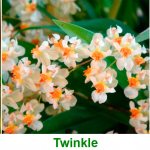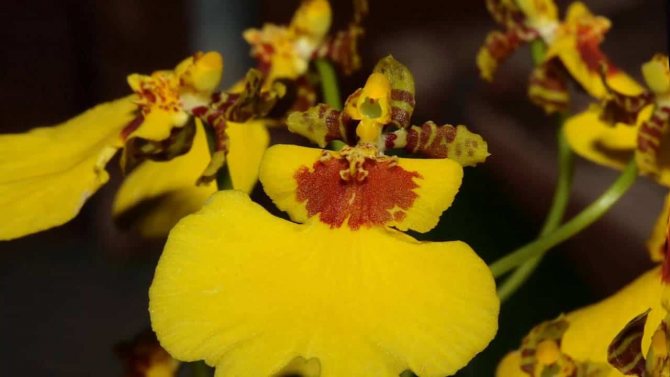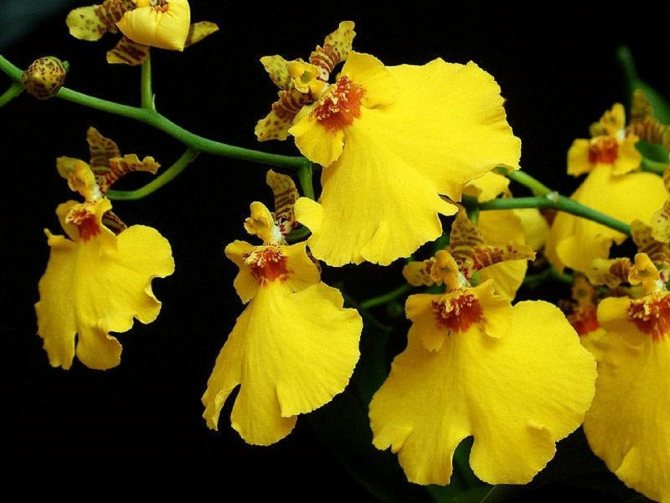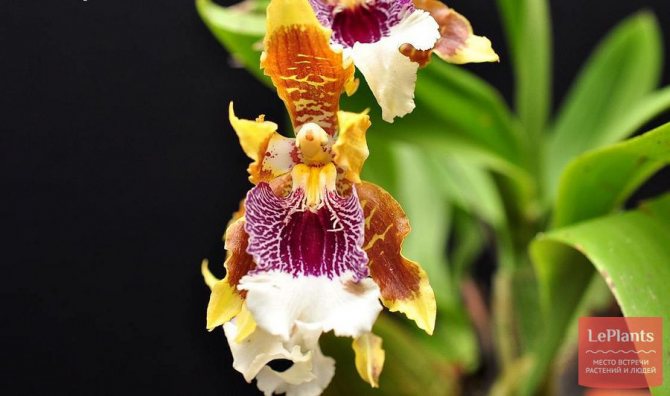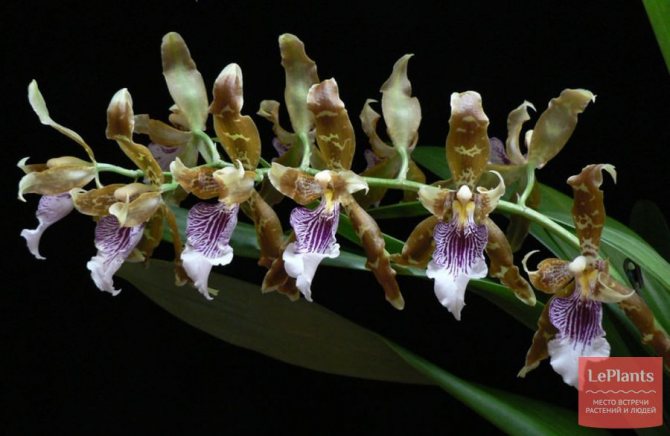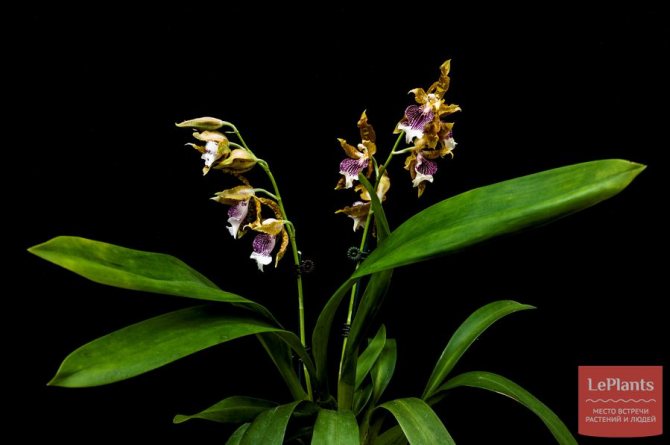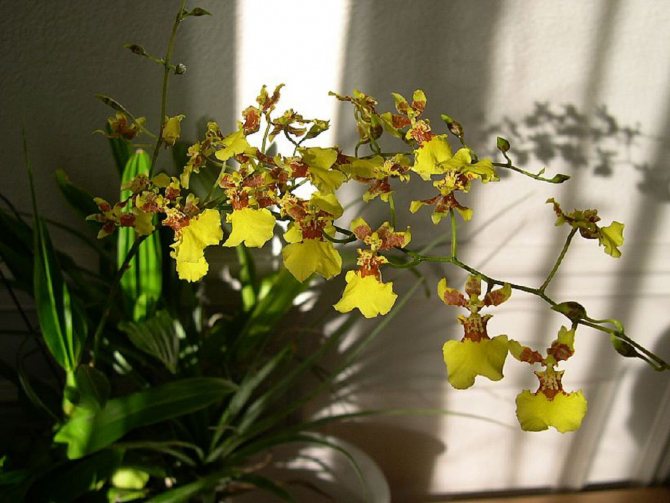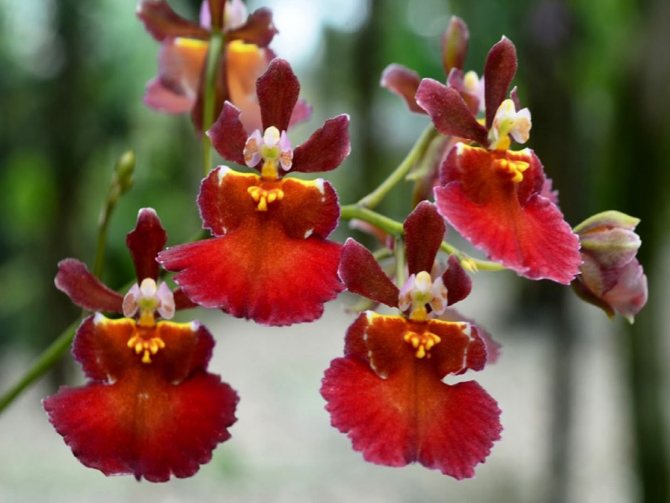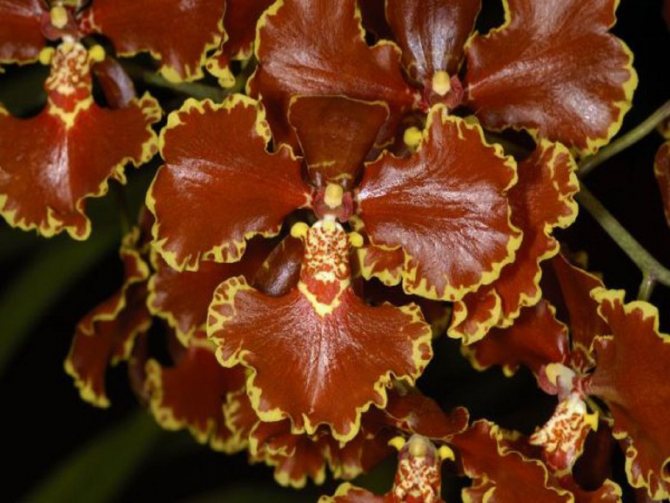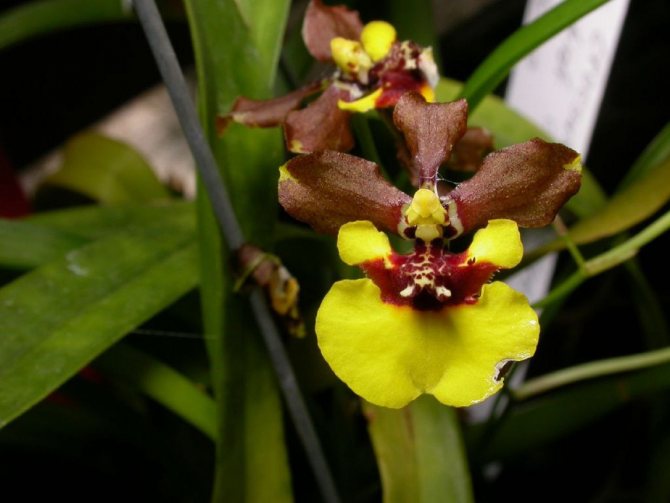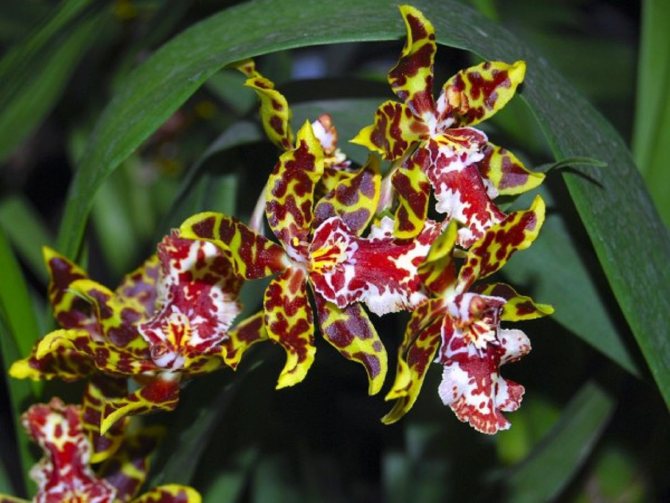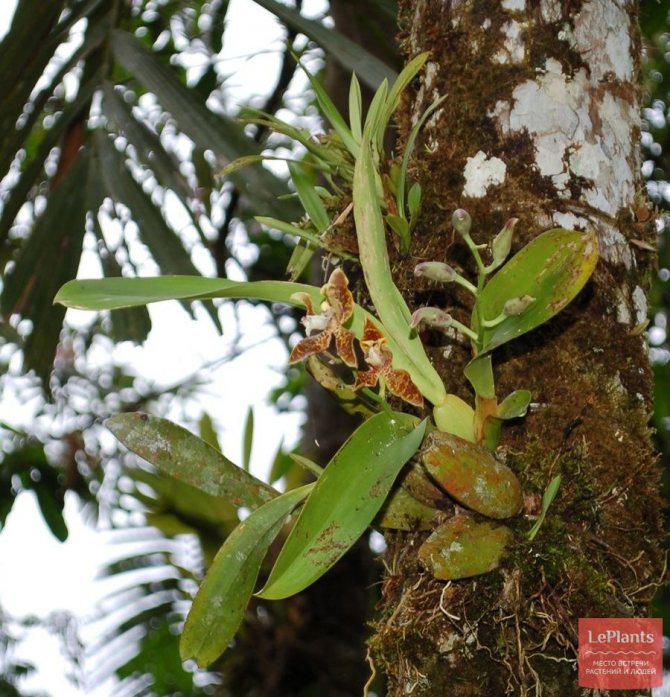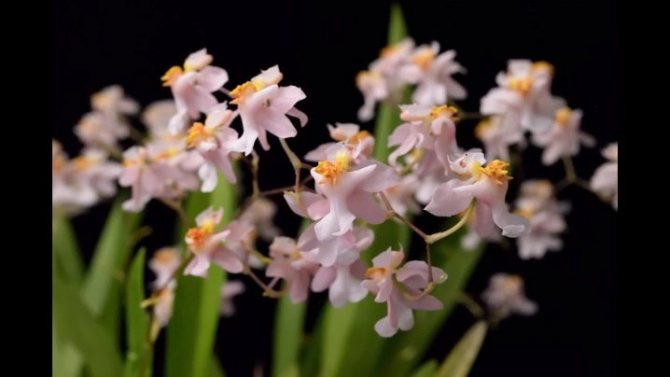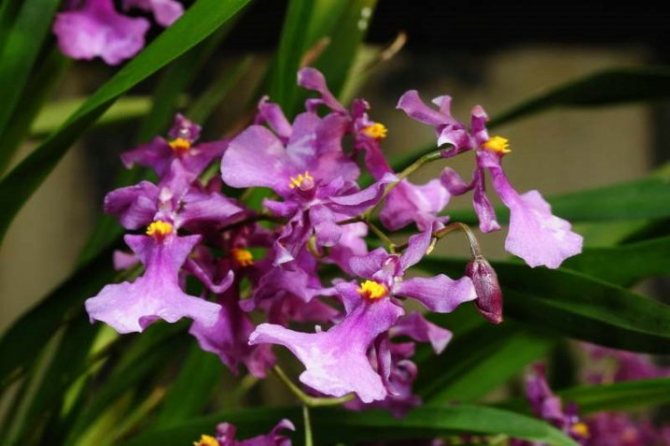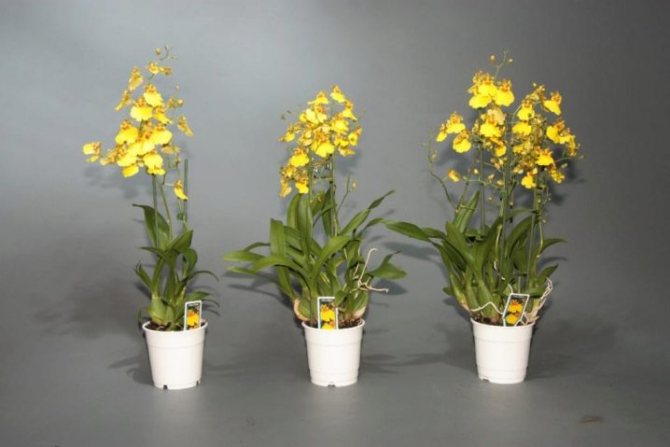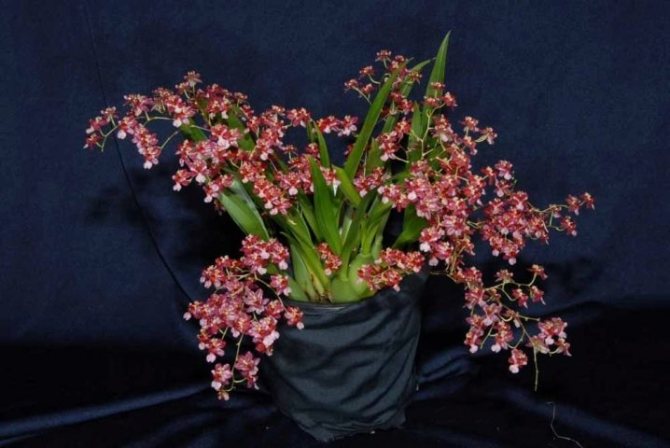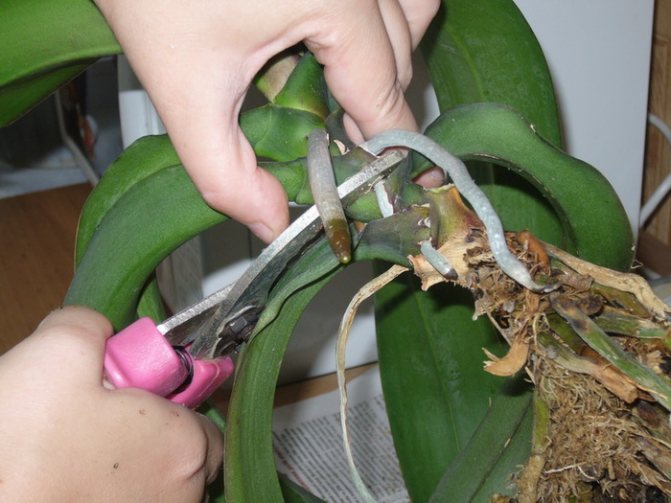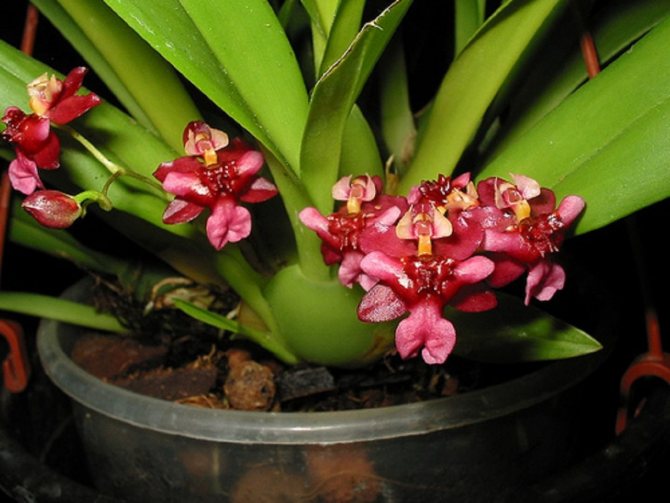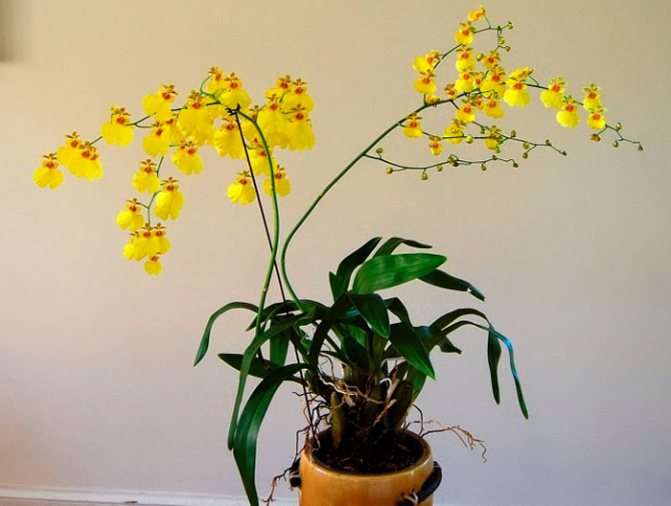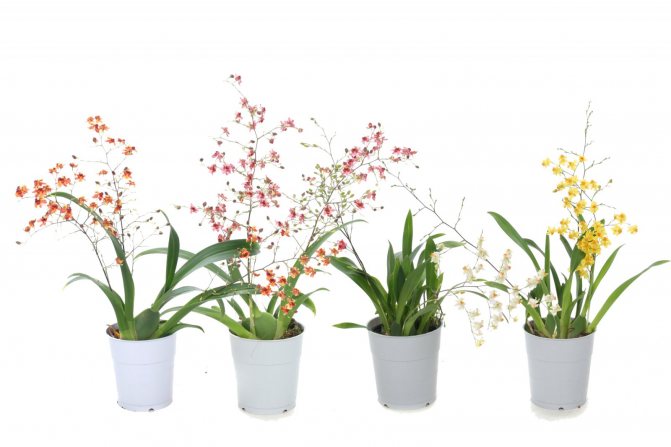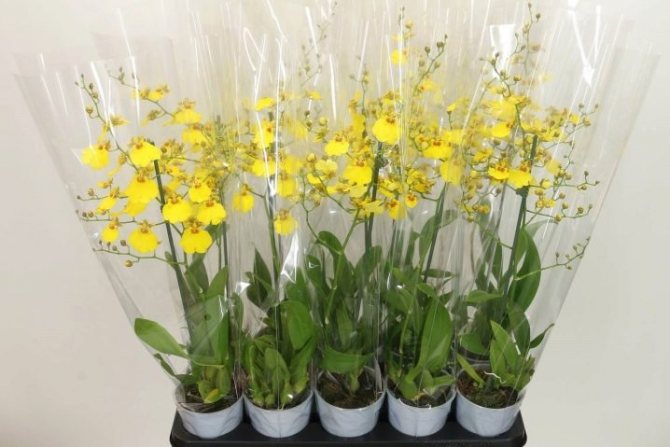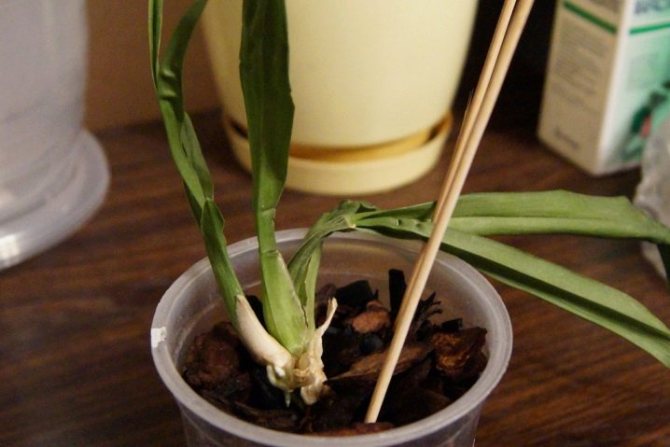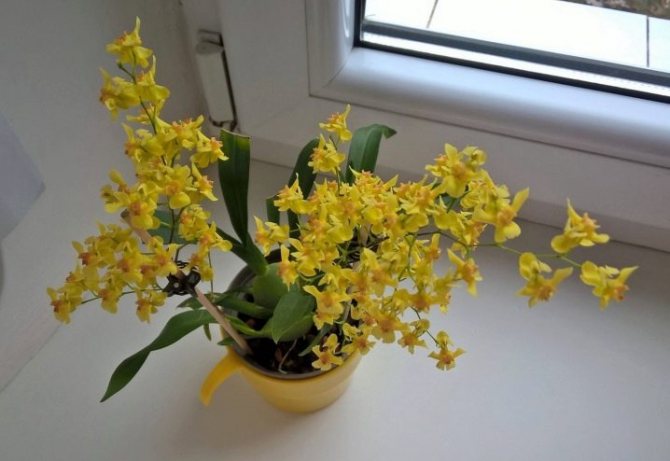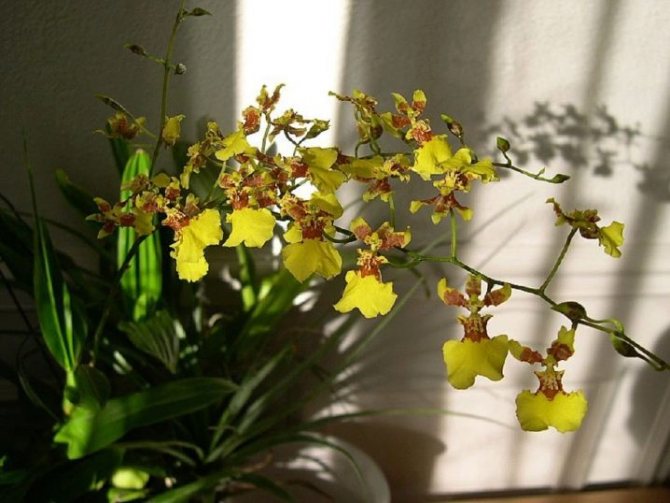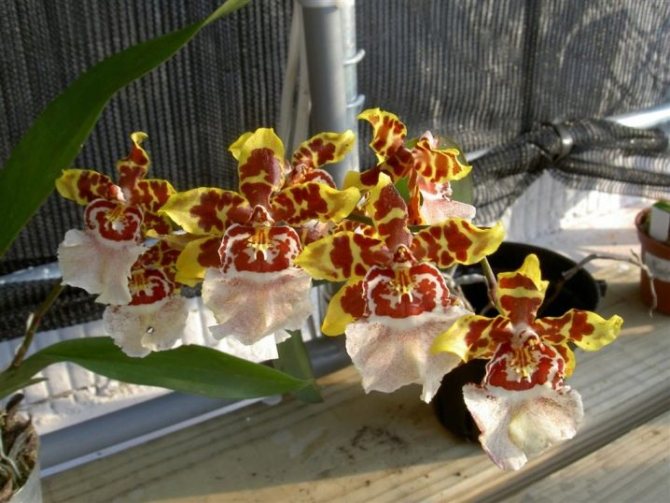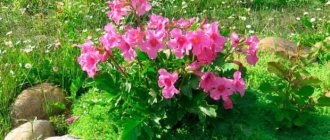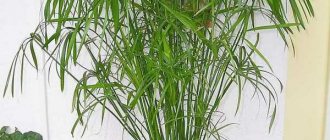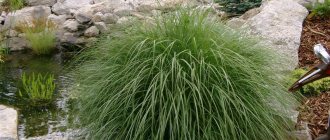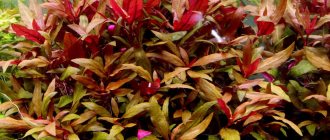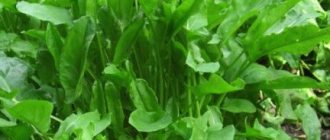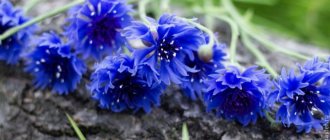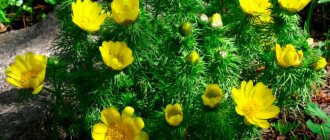The most popular among florists is orchid oncidium (Oncidium). This genus is represented by various plants that differ both externally and growing conditions. So, there are species that prefer to grow in arid savannas, others grow in the warm and humid forests of South and Central America, and there are also those that are found only high in the mountains. In this regard, there are no uniform specific rules for caring for this plant, as well as their hybrids. In each specific case, it is necessary to take into account which parental species a particular hybrid originated from. The most important thing in caring for such orchids is the choice of the correct temperature regime, their drought resistance and the features of the dormant period.
Oncidium differs from phalaenopsis in that it is more tied to temperature changes during the day, and also loves light very much. Most of the species of this plant are epiphytes and they are able to live even on a stone. In this regard, they do not tolerate excessive moisture in the root system.
It is worth considering that oncidiums of Dutch origin are for the most part very beautiful hybrids that do not require special conditions for keeping. They are easy enough to grow at home and at the same time they bloom quite effectively. You should also learn more about cambria - this name of hybrid orchids is a general trade name. These hybrids are obtained by crossing a wide variety of species of the oncidium group, as well as oncidiums. Such hybrids are also quite unpretentious.
It is quite easy to distinguish an oncidium hybrid in a flower shop. He has a branched and rather long peduncle, on which there is a large number of small flowers, similar to dancing dolls or moths. As a rule, they are colored brownish yellow or red. The flower has several pseudobulbs that are thickened. And from them are narrow long leaves, which are folded in the shape of a boat. Most often on sale there are such hybrids as:
- Sweet sugar (Onc. Aloha Iwanaga x Onc. Varicosum) - it is the most popular and distinguished by its unpretentiousness, has many small yellow flowers;
- Twinkle (Onc. Cheirophorum x Onc. Ornithorhynchum) are compact hybrids, they have small fragrant (up to 15 millimeters) flowers, which, depending on the variety, can be colored yellow, white or red.
- Sharry baby (Onc. Jamie Suttonx Onc. Honolulu) - this series has many small flowers that have a fairly strong smell of chocolate and honey, and depending on the variety, they can have a red, dark purple or brownish yellow color.
In the store, you should opt for a plant that has at least 3 mature pseudobulbs. Only in this case the purchased flower will grow and develop normally. If the oncidium has less than 3 pseudobulbs, then the flowering of such a plant in the store is artificially stimulated, and when grown in room conditions, serious problems often arise with it. If the pseudobulbs are slightly wrinkled, then this is completely normal. When buying, you should also pay attention to the root system. The roots should be light in color. The soil should be slightly damp (not dry or flooded).The root system reacts negatively to stagnant water in the soil, as well as to dryness, which lasts for a long time. If there are brownish spots on the foliage, then it is better not to buy such plants.
Description of oncidium
| Genus | Oncidium |
| Family | Orchid |
| Homeland | Central and South America |
| Escape type | Straight |
| Inflorescence | Brush or duster |
| Petal color | Diverse |
| The structure and color of the leaves | Belt-shaped, dark green |
| Flowering period | All year round |
| Fetus | Does not have |
| Reproduction | Dividing the bush, pseudobulbs |
According to the botanical description, oncidium is a perennial evergreen herb, reaching 4 m in natural conditions. Very often this orchid is bred in apartments. This culture is in high demand for flower growers for its long flowering and very beautiful, expressive buds.
The rhizome of the plant is strong, long or short, penetrates even into dense rocky soil, where it fixes well and continues to develop even in harsh conditions.
Elongated pear-shaped light green pseudobulbs are located above the roots.
The height of the oncidium at home is 15 - 45 cm.
Orchid leaves are long, sessile, dense, fleshy, belt-like, rich green, with a well-defined central vein. Some types of leaf plates have a marble pattern. In some varieties of oncidium, the leaves have a cylindrical shape.
Peduncles are highly branched, straight or drooping, 10 cm or more in length. The flowers are medium in size, can be of different shades: yellow, brown, red, pink and others. Some species and varieties have spots of different colors on the petals.
Oncidium blooms throughout the year, and all this time the bush is covered with spectacular bright flowers with a pleasant aroma.
Care errors
In addition to diseases and pests, non-compliance with the rules for caring for oncidium at home causes various problems.

The most common errors are presented in the table:
| Problem | Signs | Prophylaxis |
| Decay of foliage | Excessive watering and irrigation, accumulation of moisture inside the growing point and on the walls of foliage | Normalize watering |
| Brown spots on the leaves | Acquired infection, bacterial or fungal in nature | Increase the frequency of watering, remove the affected areas, process the sections, establish free air movement |
| Wrinkles on the leaf surface and dried edges | Dry hot air, insufficient watering | Establish nutrition with life-giving moisture |
| Leaves and flowers are afflicted with white spots | Large amount of applied fertilizer | Adjust the amount and frequency of feeding |
| Young buds turn yellow and fall off | Plenty of sunshine | Move to shade |
| The tips of the leaves dry up, the bulbs wrinkle | Excessively low indoor humidity | It is necessary to spray the plant with a spray bottle |
Important! To avoid mistakes, you need to take care of the Oncidium orchid thoroughly. And in order to exclude pests or the growth of the disease, it is recommended to control the condition and, at the slightest malaise, eliminate the cause of the disease.
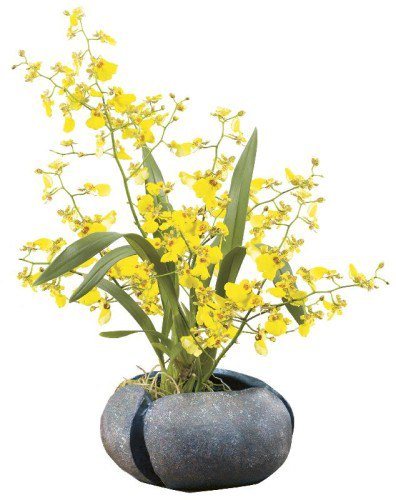

Varieties of oncidium flower
Oncidium is yellow.
This variety is one of the most unpretentious, for which it is especially appreciated among lovers of flowering plants. During flowering, the bush is densely covered with bright yellow flowers with red spots in the center. On each peduncle, from 10 to 30 buds are formed. Flowering lasts for 4 weeks.
Oncidium Sweet Sugar.
This species is ideal for growing at home. Requiring no special care, it pleases with beautiful flowers.The leaves are long, pointed at the end, dense, rich green. The peduncle is erect, branching, 30 - 35 cm long. The flowers are large, 3 cm in diameter, with a strongly protruding lip, yellow in color, with a brown spot at the base.
Beautiful oncidium (Oncidium splendidum).
Possesses decorative curved, rich green foliage. Inflorescences are yellow.
Oncidium twinkle.
A hybrid bred specifically for growing in apartments. A miniature plant, the height of which does not exceed 10 cm. The peduncle produces a large number of buds of yellow, red, white, pink color with a very pleasant vanilla aroma.
Oncidium warty (Oncidium varicosum).
Another well-known variety of the oncidium flower, which is available in the collection of many flower growers - connoisseurs of orchids. It is a lush bush with long, belt-like leaves. Forms a huge number of inflorescences, which emit many bright yellow buds. Flowering occurs in August and lasts until October. For 2 months, the owner of the orchid can enjoy a truly mesmerizing sight.
Limming oncidium (Oncidium limminghei).
A low-growing species of orchid, reaching 8-10 cm in height. One shoot throws out only one bud, which distinguishes the plant from other varieties of this culture. The flowers are yellow, 4 cm in diameter. The bush forms buds all year round.
Sinuous oncidium (Oncidium flexuosum).
This orchid looks like a spreading bush due to the leaves that are strongly spread out to the sides. Flowers 3 cm in diameter, yellow, with a brown base, collected in a paniculate inflorescence. Flowering occurs in mid-summer. Lasts for 1.5 months.
Beautiful Oncidium (Oncidium splendidum).
It has straight, dense oval-elongated dark green leaves. The flowers are lemon yellow, up to 8 cm in diameter. 15 - 20 flowers can form on one bush.
Tiger oncidium (Oncidium tigrinum).
Spectacular orchid with large flowers 7 - 8 cm in diameter. Petals are yellow with brown strokes.
Oncidium moth (Oncidium papilio).
The plant has flat pseudobulbs that form dark green leaves with a marbled pattern. The flowers have an unusual shape that resembles the wings of a butterfly. The petals are yellow with a brown border along the edges and spots of the same color. At the base of the flower there are elongated thin tubes.
Oncidium lance (Oncidium lanceanum).
Leaves are dense, fleshy, bright green, with small brown specks along the edges. The lower part of the leaf blades has a more intense color than the upper one. Flowers are yellow-green, formed on a long peduncle in several pieces.
Oncidium torch-like or scorched (Oncidium sphacelatum).
An orchid with long, tough, pointed at the end, dark green leaves. The flowers are yellow with red-brown spots. Their diameter is 3 cm. Flowering begins in November and ends in February.
Curly oncidium (Oncidium cricpum).
The plant is distinguished by unusual flowers with petals wavy along the edge. The petals are light brown with yellow spots. The peduncle is straight, branched, 25 - 30 cm long.
Bird-billed oncidium (Oncidium ornithorhynchum).
Unusual appearance of oncidium, with small flowers with a diameter of 2 cm, having a sharp sepal. The petals are narrow, serrated along the edge. Flowers can be pink, lilac, white, yellow.
Below in the selection of photos you can see how each type of oncidium blooms and what shades of buds are characteristic of them:
Distinctive features of culture
Oncidiums have no common characteristics - the appearance is determined by the type of flower. Among them there are undersized (only 15 cm) and tall (up to 40 cm) species, there are lovers of a warm, humid climate with hard leaves, and there are lovers of shady places with thin narrow leaves. Pseudobulbs do not grow in all species, therefore, the accumulation of moisture in them occurs at the base of the leaf.
The genus got its name because of a special comb-like growth on the lip (onkos - tubercle, tumor + eidos - species, image).


Fragrant flowers (diameter from 1 to 12 cm) of various colors are collected in inflorescences from 0.1 to 5 m long. The most common flowers are yellow and brownish-red.There is no definite flowering period - flowers can form twice a year, if the necessary conditions are created. Flowers live for a long time - from 1 to 1.5 months.
Recommendations for the care and maintenance of oncidium orchids at home
Lighting. Oncidium is a light-loving orchid that can form abundantly buds only with enough light. When choosing a place in the house for keeping it, you need to focus on those window sills where the flower will be in the sun as long as possible. The south window is the best fit for this crop, but you should pay attention to the leaves. Direct rays can leave burns on their surface, appearing as red spots. Then the plant will have to be shaded. When growing an orchid on a northern windowsill, one should hardly expect flowering, despite the fact that the flower will grow and develop successfully. In this case, an artificial plant lamp will help eliminate the lack of light.
Air temperature. Air temperature readings play an important role in orchid breeding. However, their range may differ, depending on the type of oncidium. So, tropical varieties in the warm season feel comfortable at a temperature of 26 - 30 degrees, in the cold season at a temperature of 15 - 19 degrees. Temperate species should be grown at 19-23 degrees in spring and summer and 12-16 degrees in autumn and winter.
There are also varieties of oncidiums that prefer to grow in cool conditions. For them, the temperature in spring and summer is 20 - 22 degrees, in the autumn-winter period - 7 - 11 degrees.
Many hybrid species and varieties bred for breeding in an apartment can grow and bloom at a temperature of 15 - 28 degrees.
Watering. Oncidium orchid is very sensitive to watering, so this work should be given special attention. The frequency and amount of watering depends on which stage of growth the plant is in. If the flower has already formed a pseudobulb and a sprout appears from it, you need to moisten the soil often and abundantly. To avoid stagnant moisture, which will damage the root system, it is necessary to choose the right pot. It must have drainage holes. For watering an orchid, it is important to use warm, settled water.
Air humidity. When caring for an oncidium orchid when keeping a house, it should be borne in mind that it can grow and bloom both with low and high air humidity. But if dry air is combined with intense heat, you should spray the bush daily using soft filtered water. Spraying is also carried out in winter, when heating devices start to work. If spraying is neglected, orchid leaves will dry out.
To increase the humidity of the air at a time when it is necessary, special devices - humidifiers - will help.
The soil. For planting oncidium, a light, loose, air-permeable and permeable soil is suitable, which can be prepared at home by mixing crushed pine bark, perlite and charcoal in a ratio of 3: 1: 1. A composition of pine bark, peat, sphagnum and charcoal, taken in a ratio of 2: 1: 1: 1: 1, is suitable.
Specialty stores sell orchid potting mix, which is also suitable for growing oncidium.
Top dressing. The plant needs nutrients for the active formation of new shoots, therefore, when growing this crop, fertilizers should be periodically applied. This work is performed during the period of intensive plant development, that is, from March to September, 2 times a month. As a top dressing, a mineral complex for orchids is used. The fertilizer is diluted in water, reducing the dose by 2 times compared to that indicated on the package. Top dressing is added during watering.
To understand how the oncidium orchid care is carried out at home, the following photos will help, where the main nuances of this work are well traced:
Growing conditions
Oncidium is light-loving, therefore it prefers western, eastern or southern windows. On the north side, the shrub will refuse to bloom. On the southern windowsill, it is recommended to shade the flowerpot in the midday heat.
The temperature regime for different types has its own differences, presented in the table:
| Characteristic | View | Summer | Winter |
| Heat-loving varieties | Papilionaceous Lanza | + 25 ... + 300С | +15 .. + 190C |
| Species developing at medium temperatures | Tiger Beautiful | + 20 ... + 250C | +12 .. + 160C |
| Cold-loving representatives from mountain forests | Winding Warty | Up to + 220C | + 7 ... + 100C |
| Hybrid views | Sweet Sugar Twinkle | +14 .. + 250C | +10 .. + 220С |
Important! Humidity for shrubs should not be reduced below 40%. If the room is hot and dry, then the flowerpot must be moved away from the heater and sprayed well. If the temperature has dropped to +15 .. + 180C, then you should not irrigate the leaves from a spray bottle.
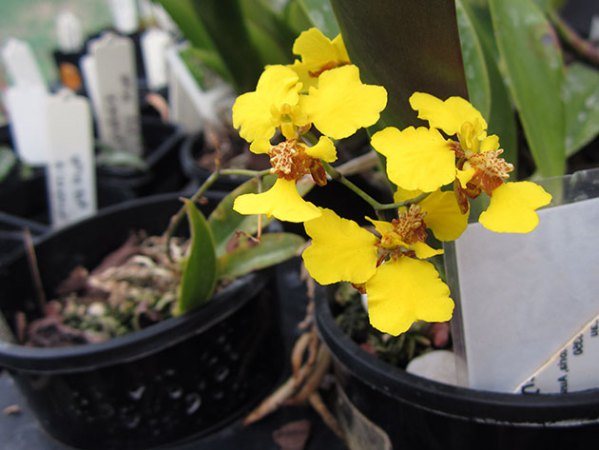

How to transplant oncidium
The orchid needs a transplant once every 3 years. This work is carried out in the spring during the active growth of shoots. It is important to carry out the transplant correctly so as not to damage the plant, otherwise it will hurt and take root for a long time.
So that the bush can be easily removed from the previous pot, you should moisten the substrate, wait 20 minutes. After that, the plant is quickly and effortlessly removed from the soil. It is necessary to examine the roots and remove the damaged ones.
The oncidium should be transplanted into a plastic or ceramic pot, which should be slightly larger than the previous one.


At the bottom of the new container, you need to place a drainage layer of small pebbles or broken brick, pour fresh substrate on top of half of the pot and place a flower in the central part, pointing the roots in one direction. Then fill up the soil. It should be borne in mind that the bulbs must be on the surface of the substrate, so they cannot be buried. After planting, the plant is placed in a shaded place and not watered for a week.
If you take into account the above recommendations for caring for oncidium, you can achieve great success in breeding it.
Planting and transplanting
A transplant for the oncidium orchid is needed if the old substrate has completely outlived itself (clogged, caked). And it is also necessary to replace the flowerpot if the roots do not fit into the container.
Worth knowing! 3 years is the optimal gap between transplants and soil changes.
The time for transporting oncidium to a new pot is February-March, after a period of rest, before the formation of a young stem.
The flower needs to be removed from the old flowerpot. Oncidium rhizomes are cleaned of the spent substrate. If the remnants of the bark have adhered to the roots, then the plant must be placed in a warm liquid. After the rest of the soil will quickly go away.
Before planting in a new flowerpot, you need to inspect the rhizomes of Oncidium. All dead, decayed or injured roots, as well as non-viable pseudobulbs, should be carefully cut off. An open wound must be sprinkled with charcoal powder, colloidal sulfur or Fundazol.
A new pot for oncidium needs to be taken slightly larger than the previous one. It should be wide, shallow and darkened (matte). Pine bark without any additives is ideal for soil. But many additionally add river sand, charcoal and chalk.
Starting the planting process, expanded clay, pebbles or foam is laid out on the bottom. Then place the bark of a large size. Next, the plant is established, while the rhizomes are carefully laid out. All empty places are covered with small bark.
The oncidium orchid positions the pseudobulbs above the surface of the new substrate. The last step in transplanting is to irrigate the shrub with Fundazol (2 grams per 1 liter of water).
Diseases, pests and resuscitation of oncidium
During the cultivation of an orchid, you can sometimes encounter an invasion of pests and diseases. Resuscitation of oncidium is possible if the florist recognized the problem in time and immediately took measures to eliminate it.


Mealybug can often be found on this plant. It is not difficult to recognize it. White small fluffy lumps appear on the leaves. To eliminate them, you need to wipe the sheet plates with wet wipes soaked in water with the addition of alcohol. After that, the bush should be treated with Aktara or the like.


From time to time a scale insect settles on an orchid, the presence of which will be indicated by wax spots on the surface of the leaves. They are also removed using a damp cloth dipped in an alcohol solution. Then the bush is sprayed with an insecticide.


Thrips are among the most common pests of oncidium. When this pest appears on the leaves, you can see silvery thin stripes. In the fight against insects, the Actellik insecticide will help.
If the flower is kept in a room with dry air for a long time and the grower does not take any measures to moisten it, a spider mite will very quickly settle on the bush. At the same time, small white dots and a cobweb can be found on the plant. This insect can severely damage the orchid if not eliminated during the process. To combat insects, insecticides "Antikleshch", "Fufafon", "Akarin" and others are used.
If a florist neglects the rules for the care and maintenance of oncidium, quite often his pet begins to get sick. If the irrigation regime is violated, namely from excess moisture in the soil, brown spots appear on the buds. The leaves begin to rot. When these signs appear, it is necessary to adjust the watering.
Also, excess moisture in the substrate leads to root rot. Root rot quickly spreads to leaves and shoots, and if the disease is not recognized in time, the plant may die.
With dry air in the room where the flower is located, the tips of its leaves begin to dry out. The best preventive measure is regular spraying.
If the leaves dry out along the edge, this is due to rare watering, or a lack of nutrients in the soil. When this sign appears, you need to pay attention to the condition of the earthen coma and, if necessary, apply fertilizer.
Preparing for flowering and leaving after it
With the appearance of a peduncle on a plant, you need to carefully control:
- indoor air temperature, especially at night - it should not be higher than + 18 ° С;
- watering - strictly after the soil dries out;
- root and leaf dressing, contributing to the establishment of flower stalks and accelerating flowering.
As soon as the first flower blooms, watering and fertilizing are stopped. Only temperature indicators are monitored - the difference between night and day should not be more than 3 ° C.
Important! During the flowering of orchids, pseudobulbs may shrink slightly - this is a natural process that is not evidence of a deviation in the development of the plant.
After flowering, the oncidium begins a dormant period. At this time, the plant must be transferred to a cooler place, organizing a winter temperature regime there in accordance with the characteristics of the flower. Top dressing during the dormant period is not applied at all, and watering is carried out by soaking no more than once every 20 days.
Reproduction of oncidium
Propagation of a spectacular flower is quick and easy. In order to get a new plant, two methods are used: dividing the bush, jigging pseudobulbs.
It is possible to propagate oncidium by dividing the bush only if there are at least 7 pseudobulbs on it. This work is recommended to be carried out during transplantation.The best time to divide is spring. A sharp, clean knife is used in the work. The cut sections are processed with crushed charcoal. After that, they are seated in new containers filled with substrate, and removed to a shaded place. Watering is not carried out for 10 days.
If there are already pseudobulbs on the bush, it divides into parts on its own without any intervention. If you want to remove a part of the plant from the pot, you need to dig it out, use a sharp, disinfected knife to separate the area with pseudobulbs and sprinkle the cut sites with activated carbon. You can leave the bush in the same pot, then two orchids will grow in one dish, which will delight you with many new shoots and buds.
Prevention of various problems
Prevention consists in regular proper care of the oncidium orchid... Maintain a resting phase, prevent drafts, overheating, and timely fertilize.
For other types of orchids, see our separate materials. Among them: Bulbophyllum, Cymbidium, Liodoro, Miltonia, Cattleya, Vanilla, Cambria, Philadelphia, Sogo and Brassia.
Recommendations when buying a plant
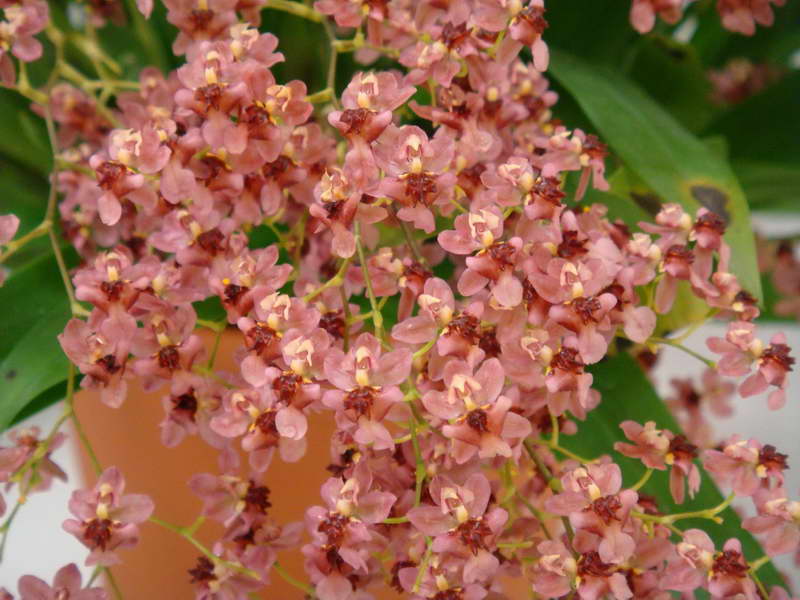

Oncidium twinkle pink photo
When choosing a plant in a flower shop, take a close look at it. There should be no stains on the leaves, as this is evidence of disease. An oncidium should have at least three pseudobulbs, and ideally, the roots protrude above the surface of the dry substrate.
After purchase, quarantine the oncidium for 2-3 weeks, i.e. set aside a place separate from other plants.
If the substrate has turned into a dusty substance, you find a dense lump of moss inside the flowerpot, or the roots of the plant begin to rot, an emergency transplant is necessary. Under normal conditions, transplants should not be disturbed once again.
Testimonials
Elena N. “An excellent plant with stunning flowers, very demanding on soil moisture, growing temperature. With proper care, it pleases 2 times a year with beautiful flowers. I am growing Ontsidum, following the recommendations, while everything is normal, growing and pleasing to the eye. "
Boris. “I bought Ontsidum at the sale. I tried to look after correctly, after a month of efforts the first results appeared: bulbs. Then a lovely peduncle emerged from her, and my joy knew no bounds. "
Victoria Z. “I raised a young Ontsidum in a greenhouse, developed well, as soon as it was transferred to a room with dry air, it began to dry out. After consulting with experts, I decided to gradually accustom my orchid to life in a room with dry air. This was my main mistake, you need to gradually open the greenhouse, so that the orchid gets used to it, and then move it into the room. This was my main mistake. "
Evelina Z. “I got a Hawaiian sunset on the Ontsidum market, it was already blooming on one peduncle. I follow all the tips that I was given in the store. There are not many flowers on it, but when each of them blooms, it is an amazing sight. In order for the orchid to develop comfortably, it is necessary to observe the regimes of rest and active vegetation. "
Resuscitation of a plant without roots
With excessive moistening of the soil, due to improper care, or simply from old age, oncidium can lose all or most of the roots. In this case, urgent resuscitation of the orchid is necessary. In such a difficult period for a plant, all conditions must be created so that it grows new roots. In this case, the pseudobulbs must be in good enough condition, only in this case the flower can still be saved.
- Trim all damaged roots (if any) to healthy tissue. Burn the slices with greenery or treat with fungicide.
- Let the wounds dry and heal for 18-24 hours.


With excessive moistening of the soil, from old age or due to improper care, the oncidium often loses its roots - Prepare pieces of bark about 1x1 cm in size. Boil them for 15 minutes and dry.
- Mix them with a small amount of steamed sphagnum moss, crushed (about 4: 1). Place the substrate in a shallow dish.
- Place the pseudobulba on the surface of the ground with the base down and fix it in this position with wooden sticks.


If the orchid has no roots, then you can fix it in the substrate by tying it to a support - The flower will receive food and moisture from pseudobulbs, so they need to be often sprayed with warm water. Once a week, it is necessary to add fertilizer for orchids to it, carrying out foliar feeding.
- Please be patient, the first results will begin to appear in at least two months. A young tuberidia will appear from the growth point, which will grow roots over time.
Video: resuscitation of an orchid that has lost its roots
How to care for oncidium at home video
How to water oncidium
Water should be abundant and frequent throughout the warmer months. There should be drainage holes at the bottom of the pot to allow for normal water drainage. Stagnant moisture will lead to decay of the root system. Also, do not allow the substrate to dry out completely, as the roots may not recover. Watering is carried out by immersing the pot with the plant in purified water (rain, melt, filtered or settled) at room temperature for about 20 minutes. Let the water drain well. Water about once every 7 days in summer, in winter - once every 2-3 weeks.
A large number of pseudobulbs takes a lot of energy from the plant, which will negatively affect flowering. Use a trick: as soon as a new pseudobulb begins to form, stop watering, the appearance of a peduncle will be a sign to resume watering. This "stress" stimulates flowering. Do not worry if the pseudobulb shrivels during flowering or dormancy - this is normal.
Air humidity
Oncidium feels great with an air humidity of about 40% and does not require any additional manipulations. In hot summer weather or during the period of operation of heating systems, the air can be very dry, therefore, for full development, you should take care of air humidity. Spray the leaves of the plant periodically, place them on a tray with moisturizers (expanded clay, pebbles, sand). At air temperatures below 18 ° C, the plant should not be sprayed.
To avoid fungal infection, regularly ventilate the room, but do not allow a draft.
Top dressing
The plant is very sensitive to the amount of fertilizers in the soil. Use special dressings marked "for orchids", they need to be diluted at a concentration of 1 to 10. Fertilizer is applied during the growth of young shoots, and when the pseudobulb begins to form, they stop. The next "wave" of dressings: from the appearance of the peduncle to the opening of the first flowers. Alternate root dressing with leaf spraying.
Problems when growing oncidium
Violated conditions of keeping this or that type of oncidium lead to the appearance of defects on its leaves or flowers.
- Spots on buds and flowers, rotten leaves indicate excessive moisture in the substrate. In this case, it is important to adjust the watering before the plant begins to die.
- A rotten root system also indicates over-watering or drafts.
- If the air humidity is too low in summer or when the plant is placed near heating devices in winter, the tips or edges of the leaves will begin to dry and turn brown.
It is important to remember that any purchased plant must be quarantined for 30 days before placing it with other green inhabitants on the windowsill.
How to create an optimal microclimate for a flower
The climatic conditions of tropical rainforests in which oncidiums live in nature are very different from those that are created in modern apartments. Therefore, before purchasing this orchid, it is necessary to take into account its "requirements" and, if possible, recreate the correct microclimate in the room. Also, the flower has a pronounced dormant period, respectively, the conditions of detention change throughout the year.
Table: optimal conditions for growing oncidium
| Factor | Recommendations |
| Location | Sill of a window facing south or southeast. The plant does not tolerate stale air, so the room must be regularly ventilated. In summer, it is useful to take the pot out to the balcony, veranda, or garden. There, the required temperature difference is achieved naturally. |
| Lighting | Light is required bright, but diffused. The plant shades from direct sunlight. Daylight hours are 10-12 hours all year round. In winter and autumn, the orchid is supplemented with special phytolamps (from ordinary leaves, they acquire an unnatural purple hue). |
| Temperature | During the active growing season - 24–26 ° C during the day and 18–20 ° C at night. Such a drop during the day is a necessary condition for flowering. In winter, the temperature is lowered to 15–17 ° C. |
| Air humidity | The optimal rate is 50–70%. In extreme heat and in winter, oncidiums are sprayed so that drops do not fall on the flowers. Wet expanded clay is placed in the pallet. You can also place special devices in the room that humidify the air, or put the pot in the florarium. If the room temperature drops below 18 ° C, additional humidification must be stopped. |


At the time when solar activity is maximum, oncidium must be shaded.
Memo to the florist
How to achieve flowering oncidium
If the plant refuses to bloom, you need to reconsider caring for it. It is imperative to strictly adhere to the resting phase, to achieve a decrease in temperature at night by 4 degrees. It is impossible to remove bulbs even with a wrinkled look. This can deprive the plant of the nutrients it needs to bloom.
Resuscitation of oncidium
First you need to do an inspection of the roots. Remove all rotten and sore spots. Then wash and inspect again. You need to cut off the bad places until only healthy tissue remains. Then leave the culture for a few hours to dry. Treat the cut sites with disinfectants (cinnamon, charcoal). Plant in clean pine bark. No need to water.
You can see how to divide the oncidium bush in the video from the flower grower Irina, we wish you a pleasant viewing.

